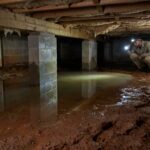Essential Guide to Effective Basement Waterproofing Techniques for Homeowners
Basements can be a wonderful feature in your home: they offer storage, additional living space, or even the perfect spot for an indoor gym. However, a basement can also be the site of unwanted guests—water and moisture. When water decides to make a surprise visit to your lower level, you might find yourself in a soggy situation that leads to mold, structural damage, and all-around chaos. Don’t fret! This essential guide will take you through effective basement waterproofing techniques that any homeowner can implement. Let’s make your basement a water-free haven.
Understanding the Basics of Basement Waterproofing
First things first, let’s understand what basement waterproofing is. Essentially, it’s that wonderful collection of methods applied to prevent water from entering your basement. Given that water likes to play hide-and-seek, it’s important to ensure it doesn’t sneak in where it shouldn’t!
The most common sources of water intrusion are:
1. **Surface Water:** Rainfall can cause pools of water around your foundation, leading it to seep inside.
2. **Groundwater:** High levels of groundwater can push moisture through cracks in walls or floors.
3. **Humidity:** Even if there’s no direct water exposure, high humidity can lead to condensation and dampness.
With these sources in mind, we can explore some techniques to keep your basement dry and your spirits high.
Exterior Waterproofing Techniques
1. **Grading Your Yard:** The ground around your house should slope away from your foundation at a decline of about 6 inches over the first 10 feet. A yard that slopes toward your foundation is like giving Mother Nature an invitation to your personal water park. Check your grading and re-slope as necessary.
2. **Install Gutters and Downspouts:** Properly functioning gutters can direct rainwater away from your home’s foundation. Make sure to clean out those gutters regularly (yes, even if it means a brief reunion with last autumn’s leaves). Install downspouts that extend at least six feet away from your foundation.
3. **French Drains:** If surface water still finds its way to your basement, consider installing a French drain. This system collects and redirects water away from your foundation. It’s like hiring a personal drainage assistant who doesn’t need lunch breaks!
4. **Waterproof Coatings:** Applying a waterproof sealant on the exterior walls of your basement can provide an extra layer of defense. These coatings create a barrier that prevents water from permeating through your walls.
Interior Waterproofing Techniques
1. **Interior Drainage Systems:** Sometimes, despite all your external efforts, water finds a way inside. An interior drainage system, such as a sump pump, can help manage any water that does make it through. This pump collects water and sends it back outside, ensuring your basement stays bone-dry.
2. **Seal Cracks and Gaps:** Look for any visible cracks in your walls or floor. Use hydraulic cement to seal these gaps, as it expands and contracts to fit the shape of the crack. Think of it as giving your basement a fresh coat of armor!
3. **Water-Resistant Flooring:** If you’re renovating or finishing your basement, opt for water-resistant flooring options. Materials like vinyl or tile can withstand moisture better than traditional wooden flooring or carpets that say “hello” to mold more often than you’d like.
4. **Dehumidifiers:** Well, if you can’t beat humidity, join it—but from a safe distance. A dehumidifier can help maintain a healthy humidity level in your basement, preventing moisture buildup. Just remember to empty the tank!
Proper Ventilation Techniques
Adequate ventilation is like opening a window for your basement, allowing it to breathe and reducing moisture levels. Here are some options to consider:
1. **Windows:** If your basement has windows, ensure they can open or install ventilation fans. It’s great for airflow and makes your basement feel less like a cave.
2. **Air Vents:** Installing air vents in your basement can help circulate air. Using these in conjunction with exhaust fans can dramatically reduce humidity levels.
3. **Insulation:** Insulating basement walls can prevent condensation. Ensure you use moisture-resistant insulation materials. You want to keep the heat in, not the moisture!
Preventive Maintenance
Once your waterproofing measures are in place, regular maintenance is key. Think of it as an annual physical for your basement. Here are some practices to keep it healthy:
1. **Regular Inspections:** Check your basement for signs of moisture, water stains, or mold. Catching issues early can save you from bigger problems down the line.
2. **Gutter and Downspout Maintenance:** Keeping gutters clear ensures they effectively manage water. Clogged gutters are like having a blocked artery—no good comes from it.
3. **Seasonal Checks:** After heavy rains or melting snow, inspect your basement and surrounding areas. Snow can add significant weight and water when it melts, so an annual spring check is helpful.
4. **Landscaping:** Keep landscaping away from your foundation. While that bush may look lovely, it can trap moisture against your home.
Knowing When to Call a Professional
While many waterproofing techniques are DIY-friendly, sometimes you need to call in the pros. If your basement has severe drainage issues or if you find extensive water damage or mold, a professional contractor specializing in waterproofing may be your best bet. They can assess the situation and provide solutions tailored to your specific needs.
The Consequences of Neglecting Waterproofing
Let’s chat about why basement waterproofing should never be put on the back burner. Ignoring water intrusion can lead to dire consequences:
1. **Mold and Mildew Growth:** Moisture is a breeding ground for mold and mildew. Not only can this damage your beloved belongings, but it can also pose health risks to your family.
2. **Structural Damage:** Water can weaken the foundation of your home, leading to cracks, bowing walls, or worse! This is one case where ignoring the problem could cost you dearly—both in repairs and value loss.
3. **Decreased Home Value:** Potential buyers eye wet basements with skepticism. A history of water problems can scare off buyers faster than a raccoon in a trash can.
Conclusion
Waterproofing your basement is vital for maintaining the integrity and comfort of your home. With the right techniques and preventive measures, you can create a dry, healthy environment below ground. From grading your yard to sealing cracks and monitoring humidity, taking proactive steps ensures your basement remains a functional, enjoyable space.
Remember, a little investment in waterproofing now can save you from a soggy mess (and hefty repair bills) later. So get started today—your basement will thank you, and you’ll have peace of mind knowing it’s safe and dry!


